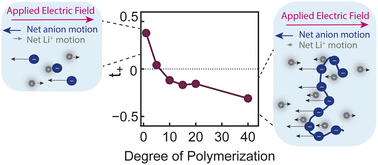Ion correlation and negative lithium transference in polyelectrolyte solutions†
Abstract
Polyelectrolyte solutions (PESs) recently have been proposed as high conductivity, high lithium transference number (t+) electrolytes where the majority of the ionic current is carried by the electrochemically active Li-ion. While PESs are intuitively appealing because anchoring the anion to a polymer backbone selectively slows down anionic motion and therefore increases t+, increasing the anion charge will act as a competing effect, decreasing t+. In this work we directly measure ion mobilities in a model non-aqueous polyelectrolyte solution using electrophoretic Nuclear Magnetic Resonance Spectroscopy (eNMR) to probe these competing effects. While previous studies that rely on ideal assumptions predict that PESs will have higher t+ than monomeric solutions, we demonstrate that below the entanglement limit, both conductivity and t+ decrease with increasing degree of polymerization. For polyanions of 10 or more repeat units, at 0.5 m Li+ we directly observe Li+ move in the “wrong direction” in an electric field, evidence of a negative transference number due to correlated motion through ion clustering. This is the first experimental observation of negative transference in a non-aqueous polyelectrolyte solution. We also demonstrate that t+ increases with increasing Li+ concentration. Using Onsager transport coefficients calculated from experimental data, and insights from previously published molecular dynamics studies we demonstrate that despite selectively slowing anion motion using polyanions, distinct anion–anion correlation through the polymer backbone and cation–anion correlation through ion aggregates reduce the t+ in non-entangled PESs. This leads us to conclude that short-chained polyelectrolyte solutions are not viable high transference number electrolytes. These results emphasize the importance of understanding the effects of ion-correlations when designing new concentrated electrolytes for improved battery performance.

- This article is part of the themed collections: 2023 Chemical Science HOT Article Collection and Electric vehicles and batteries


 Please wait while we load your content...
Please wait while we load your content...